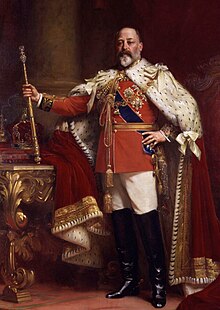WIKIPEDIA STATES:
The Edwardian era or Edwardian period of British history covers the brief reign of King Edward VII, 1901 to 1910, and is sometimes extended in both directions to capture long-term trends from the 1890s to the First World War. The death of Queen Victoria in January 1901 marked the end of the Victorian era. The new king Edward VII was already the leader of a fashionable elite that set a style influenced by the art and fashions of Continental Europe. Samuel Hynes described the Edwardian Era as a "leisurely time when women wore picture hats and did not vote, when the rich were not ashamed to live conspicuously, and the sun really never set on the British flag'".[1] The Liberals returned to power in 1906 and made significant reforms. Below the upper class, the era was marked by significant shifts in politics among sections of society that had been largely excluded from wielding power in the past, such as common labourers. Women became increasingly politicised.[2]
King Edward VII, after whom the Edwardian era is named
so the EDWARDIAN ERA is a transitional time between the Victorian era and that begins to emerge after WWI.
LITERATURE
In fiction, some of the best-known names are J. M. Barrie, Arnold Bennett, G. K. Chesterton, Joseph Conrad, E. M. Forster, John Galsworthy, Kenneth Grahame, M. R. James, Rudyard Kipling, James Joyce, D. H. Lawrence, Edith Nesbit, Beatrix Potter, Saki, George Bernard Shaw, H. G. Wells, and P. G. Wodehouse. Apart from these famous writers, this was a period when a great number of novels and short stories were being published, and a significant distinction between "highbrow" literature and popular fiction emerged. Among the most famous works of literary criticism was A. C. Bradley's Shakespearean Tragedy (1904). Mass audience newspapers, controlled by press tycoons such as the Harmsworth brothers, Alfred Harmsworth, 1st Viscount Northcliffe and Harold Harmsworth, 1st Viscount Rothermere, became increasingly important.[58]
1901-1914 The Edwardian Period
This era of literature is named after King Edward VII, due to the fact that he reigned in England during this period. This period represents the years 1901 to 1914. During this time period, England experiences great changes in the fields of science, economics, and society. Wars, advances in science, and changes in the economy greatly influenced the works, which often consist of the concerns about society and standing. The Edwardian Era works still contain traces of the Victorian style and were not quite as modernized as future works. The Edwardian age is seen as the “transitional, bridging” of the two previously stated eras.
"Edwardian Literature." Twentieth-Century Literary Criticism. Ed. Thomas J. Schoenberg and Lawrence J. Trudeau. Vol. 186. Detroit: Gale, 2007. Literature Resource Center. Web. 2 Apr. 2012.
Poem:
Convergence of the Twain
By: Thomas Hardy
I
As the IIn a solitude of the sea
Deep from human vanity,
And the Pride of Life that planned her, stilly couches she.
II
Steel chambers, late the pyres
Of her salamandrine fires,
Cold currents thrid, and turn to rhythmic tidal lyres.
III
Over the mirrors meant
To glass the opulent
The sea-worm crawls--grotesque, slimed, dumb, indifferent.
IV
Jewels in joy designed
To ravish the sensuous mind
Lie lightless, all their sparkles bleared and black and blind.
V
Dim moon-eyed fishes near
Gaze at the gilded gear
And query: "What does this vaingloriousness down here?". . .
VI
Well: while was fashioning
This creature of cleaving wing,T
he Immanent Will that stirs and urges everything
VII
Prepared a sinister mate
For her--so gaily great--
A Shape of Ice, for the time fat and dissociate.
VIII
And as the smart ship grew
In stature, grace, and hue
In shadowy silent distance grew the Iceberg too.
IX
Alien they seemed to be:
No mortal eye could see
The intimate welding of their later history.
X
Or sign that they were bent
By paths coincident
On being anon twin halves of one August event,
XI
Till the Spinner of the YearsSaid "Now!"
And each one hears,
And consummation comes, and jars two hemispheres.
Hardy, Thomas. “The Convergence Of The Twain.” Poetry X. Ed. Jough Dempsey. 25 Aug 2003. 03 Apr. 2012 <http://poetry.poetryx.com/poems/1030/>.
Critical Article on "Convergence of Twain":
Thomas Hardy’s “Convergence of Twain” is an ironic story telling of the Titanic sinking on April 14, 1912. Hardy completed this poem less than two weeks after the sinking. This poem falls under the category of “occasional” poetry, which means poems for a special occasion. The poem has a unique form, consisting of eleven tercets. According to this critic, the Roman numerals indicate a tone of formality and care. Hardy also employs an interesting metrical pattern. It is iambic for the most part. In the first tercet, Hardy gives the setting, theme, and situation described throughout the remainder of the poem. The next five stanzas demonstrate the rising tension before the ship sinks. A shift occurs half way through the poem. The first half is formal and it shifts to informal. Also, the first five are present tense and the next five are past and the final stanza present. This further emphasizes the climax of the poem, which occurs in the final stanza.
Dauner, Louise. "Thomas Hardy, Yet and Again." Modern Age 42.4 (Fall 2000): 358-371. Rpt. in Twentieth-Century Literary Criticism. Ed. Janet Witalec. Vol. 143. Detroit: Gale, 2004. Literature Resource Center. Web. 2 Apr. 2012.

Nessun commento:
Posta un commento